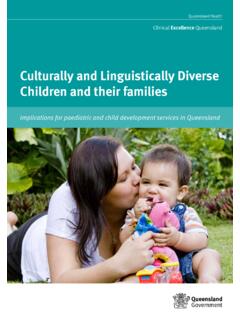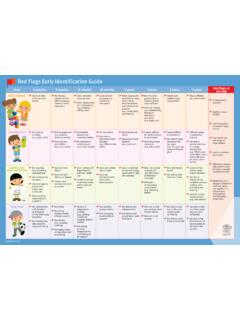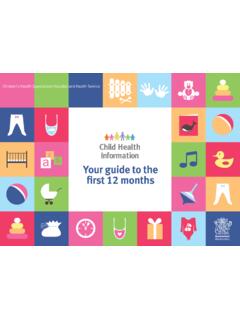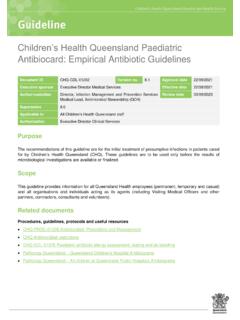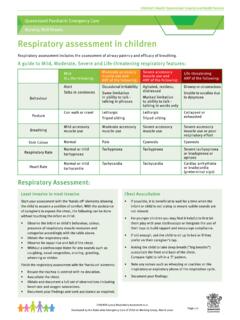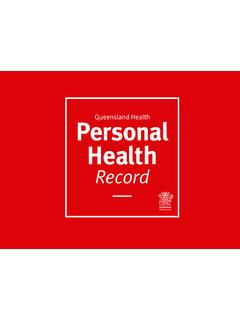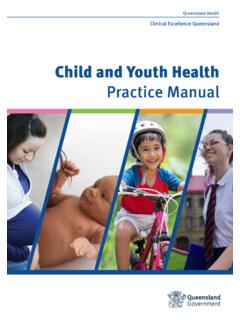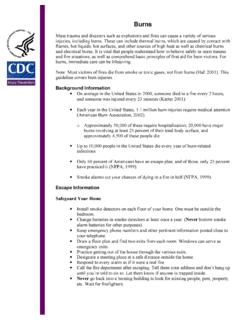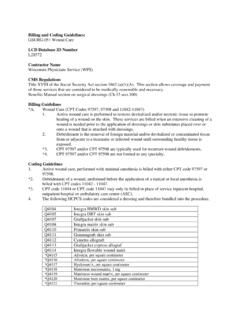Transcription of Management of a paediatric burn patient
1 Management of a paediatric burn patient Document ID CHQ-GDL-06003 Version no. Approval date 06/04/2021 Executive sponsor Executive Director Medical Services Effective date 06/04/2021 Author/custodian CNC Burns Review date 06/04/2025 Supercedes Applicable to All CHQ Clinical Staff Authorisation Executive Director Clinical Services Purpose The purpose of the document is to guide Medical, Nursing and Allied Health staff in the most appropriate way to treat a paediatric burn patient . This document includes; Introduction to the paediatric Burns Centre Referring a paediatric burns patient First Aid Estimating Total Body Surface Area (TBSA) burn Depth Fluid resuscitation wound cleansing and Blister debridement wound dressings Splinting requirements Nutrition Pain Management Complications Discharging a paediatric burns patient Scope This guideline applies to all medical and nursing staff within QH who are treating a paediatric burns patient .
2 CHQ-GDL-06003 Management of a paediatric burn patient - 2 - Introduction The paediatric Burns Centre (PBC) provides the only specialist dedicated paediatric burns centre in Queensland according to the Australian and New Zealand Burns Association (ANZBA) Guidelines. Other Burns Units in Queensland (including Townsville Hospital and The Gold Coast University Hospital) are only able to provide treatment for small to medium size burns in children. The PBC provides inpatient care (acute and rehabilitation), together with ambulatory and outreach care, for any child referred with a burn injury irrespective of size or depth. The PBC also has a burns theatre. This theatre operates twice weekly for dressing changes, microneedling, laser therapy and ranging under general anaesthetic. Currently we treat over 1000 new burns per year. The most common mechanisms of burns reviewed within the unit are: Scalds- tea/coffee, kettles, baths, noodles. Contact iron, hair straighteners, exhausts, campfires.
3 Friction treadmills, MVA. Flame kerosene, petrol, house fires. Directed by Professor Roy Kimble, our multidisciplinary team consists of Surgical Consultants, Medical, Nursing, Allied Health, psychologists, administration and research staff. We care for acute, post-acute and reconstruction burns from newborn through to adolescents, until they are then transitioned to the adult Burns Centre at the Royal Brisbane and Women s Hospital if required. While burns are predominately our primary focus, we also consult and advise on other conditions including; Meningococcal septicemia. Epidermylosis Bullosa. Scalded Skin Syndrome. Steven Johnson Syndrome. Intravenous Extravasations. Graft vs Host. Neonatal Burns. CHQ-GDL-06003 Management of a paediatric burn patient - 3 - Burns Outpatient provides Consultant led clinics Monday - Friday (except public holidays). All clinics are attended by Social Work, Occupational Therapy and Physiotherapy.
4 The PBC multidisciplinary team includes: 5 paediatric Surgery Consultants. Burns Clinical Nurse Consultant. Burns Clinical Nurse. Burns Registered Nurse. Social Worker. Occupational Therapists. Physiotherapists. Music Therapy. Dietician. School teacher. Research. Child and Youth Mental Health. Referring a burn The PBC offers a 24/7 referral service. For a referral coming from regional QLD, an email referral service is available. Criteria for referring to our service is based on the Australian New Zealand Burns Association transfer guidelines for Burns Service referral. For those burns located in the Mackay region and further north, please refer to Townsville Hospital first. For those burns located in the Gold Coast region and further south, please refer to Gold Coast University Hospital first. If they are unable to care for the patient , then please follow the information below to refer to QCH. To refer a patient to the PBC; Contact the Burns Registrar on call via switch (07) 3068 1111.
5 Complete referral form via link Further correspondence can be sent via our generic email address Attach any photos to this email if possible. If advised that the patient can be treated locally, continue to contact the burns Registrar at each dressing change to update progress and send through photos to above email address. All paediatric patients should be referred to the PBC. However they may not physically be required to attend the QCH. If treatment can be managed in the local area then this is the preferred treatment. ALERT patient referrals will not be accepted unless completed referral form is sent. Telehealth Emergency Support Unit (TEMSU) is available to improve access and provide support to emergency specialists from rural areas. TEMSU can be used for services such as: advice for acute burns; dressing instructions; debridement advice. TEMSU will link the rural area with the Burns Specialists within the Queensland Children s Hospital.
6 To contact TEMSU please call 1800114414. CHQ-GDL-06003 Management of a paediatric burn patient - 4 - First Aid Recent studies have enabled detailed recommendations for appropriate first aid in burns treatment. The application of cold water to the wound has multiple benefits including pain relief, decreased cell damage, improved wound healing and scar formation 1,2. Steps for providing adequate first aid: (1) Stop: (a) Stop drop and roll. (b) Remove all heat source including clothes, nappies, jewellery. (2) Cool: (a) Running cold tap water for 20mins. (b) Do NOT use ice. (3) Cover: (a) Use cling film to cover wound . Helpful links for further information on first aid in burns: ALERT Ensure that patient is asked how long has first aid been applied prior to admission to hospital. If less than 20mins, place under cool running water until a total of 20min has been completed. Ensure unburnt areas are kept covered and warm to prevent hypothermia First aid is effective for up to 3hrs post burns Estimating TBSA Total Body Surface Area (TBSA) is to be undertaken on admission to Emergency department.
7 While there are multiple techniques and apps that can assist with this calculation, the following are recommended: Lund and Browder form (Appendix 1). This is more accurate when estimating TBSA in paediatric patients. ITIM app, designed by NSW Institute of Trauma and Injury Management . This app includes many different calculators including estimating TBSA and Fluids Resuscitation. For small areas, the palm (including fingers), of the patient , equates to approximately 1% of the patient s body surface. Superficial burns (Erythema only) are not included in estimating burn TBSA. CHQ-GDL-06003 Management of a paediatric burn patient - 5 - Burns Depth Estimating burn depth allows us to further plan treatments for our patients and likelihood of scarring. Terminology has changed over the years with 1st, 2nd and 3rd degrees no longer used. Superficial Previously called erythema. Involve only the epidermis. These burns are not included in estimating TBSA.
8 Characterised by redness that slowly disappears, no blistering present. Superficial Partial thickness Involve both the epidermis extending into the dermis. Characterised by blistering skin, blanches when touched. Often most painful burns. Deep dermal Partial thickness Involves the epidermis and further into the dermis. Can often have areas of blistering with other pale areas. Some areas may blanche however deeper areas often will not. Can often get areas that look cherry red in colour, while it may look nice and pink these areas generally will not blanch and are caused by red bloods cells that have extravasated. Full thickness Involves the epidermis, the dermis and often extends into subcutaneous fat. These appear white in colour and can be quite thick to touch or leathery. Generally has no sensation. ALERT Burns can often change appearance within the first 72 hrs, especially scald burns. It is hard to determine depth until after the first dressing change has occurred.
9 CHQ-GDL-06003 Management of a paediatric burn patient - 6 - Fluid Resuscitation The systemic result following a burn injury causes increased capillary permeability resulting in fluid shifting into the interstitial space around the burn . This can occur up to around 24 hrs. Fluid Resuscitation is required to replace this large fluid loss over the first 24hrs. According to ANZBA guidelines, fluid resuscitation should be administered if TBSA. >10% in under 18mth old. >15% in over 18mth old. The Parkland formula is recommended (Appendix 2), with half given over the first 8 hrs from the time of injury. The remaining half is given over the following 16hrs. Maintenance fluid should also be commenced BUT must be on a separate line and NOT combined with fluid resuscitation. For large burns (>25%), Albumin has been shown to decrease total amount of fluids required. Albumin should not be used within the first 6hrs of sustaining a burn injury.
10 After this time, Albumin should be given as a 50:50 ratio to the resuscitation crystalloid. ALERT All patients commenced on fluid resuscitation should have an IDC inserted. Aim for output of 1ml/kg/hr. All patients commenced on fluid resuscitation should have an NGT inserted. Feeds should be commenced at 10ml/hr and slowly increased to full feeds within 24hrs of sustaining a burn injury. Dietician review is required. wound cleansing and Blister debridement Once first aid has been completed, the wound can be cleaned and blisters debrided in preparation for dressing application. Prior to commencing procedure, please ensure that adequate pain relief has been administered and appropriate time has elapsed for medication to become effective. To cleanse the burn wound , apply QV wash to a damp cloth. Wash wound then rinse with a clean cloth to remove soap residue. Rinse burn area using a Chlorhexidine Gluconate solution.


